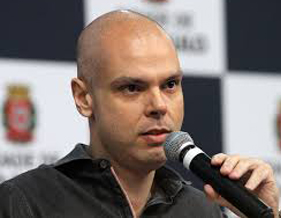August 2020, Year XII, no. 8
Bruno Covas
The Fighter Mayor
"In São Paulo, our priority has always been to save lives, and, therefore, we have taken the measures to deal with the Covid-19 pandemic with great seriousness and transparency. Our main weapons are science, correct information, and social responsibility."
Telos: In Italy, the Prime Minister is indicated by Parliament. However, every time there is talk of changing the Constitution and introducing the direct election of the Prime Minister, people use the expression ‘The Mayor of Italy’. This shows that Mayors have more power to impact on their citizens’ everyday life than even the Head of the Government. Does this also apply to Brazil?
Bruno Covas: In Italy, the Mayor is known as ‘Sindaco’, that is, the city's landlord. That is exactly the same comparison that I make here. Managing the city of São Paulo with more than 12 million inhabitants can be like a huge condo meeting where each person has a priority, but it is up to the Mayor to list the most essential and urgent ones, that can benefit a greater number of people and people with fewer opportunities. It is the duty of the public administrator to prioritise those who need it most, always. The proximity that the position of Mayor has with the population is fascinating since it is in this sphere of government that most of the claims flow through. But, for those who like people, like me, it is a great satisfaction.
The crisis of the political parties is probably the origin of the globally spread anti-political sentiment. However, this theory seems to be less true in the relationship between citizens and Mayors. Do you agree?
As I said, Mayor is the closest position to the citizens’ daily life. Street cleaning, paving work, plugging holes, services regarding basic health care equipment, and daycare vacancies are not right-wing or left-wing related. People want public services to work and to be well-assisted. It is the city in which they live and work, where every action by the public power directly impacts everyone's life. In a Municipal Election, the polarisation that was instituted in the Brazilian Presidential Elections in 2018, for example, is not part of the sentiment of those who go to the polls in the cities. People vote for who they believe will bring better solutions to social, housing, janitorial, and many other problems that bring more comfort to the routine of millions of residents. The antipolitical feeling is due in large part to the excesses and cases of corruption that are finding more and more visibility with the improvement of the Institutions. The important thing is to distinguish good policy and bet on it as a necessary change.
A long-standing politician, on October 2016, you were elected Deputy Mayor of São Paulo, and in April 2018 you took office as Mayor. What are the main differences you have experienced between being a Mayor and the other governmental posts you held? And please tell us about the biggest challenges you have been facing in administrating the largest city in Brazil.
I have already been a State Deputy for two terms, Federal Deputy, Secretary for the Environment of the State of São Paulo, and Deputy Mayor on the ticket with the current Governor, João Doria. All the experiences were essential to be in the position of Mayor today, which is, until now, the most important and the one that brings me the most satisfaction since I have the opportunity to carry out works and actions that directly benefit people's reality.
Since I took office in the city of São Paulo, I have been faced with many challenges, in addition to those of the daily life of a great world metropolis. I went through the fire and collapse of a building invaded by homeless residents, a national truckers strike that prevented the supply of food and fuel in São Paulo, the fall of a viaduct as a result of years of non-existent preventive maintenance, a personal battle that was the discovery of cancer with metastasis and, subsequently, the confrontation of a global pandemic coming from an invisible enemy. There is a phrase from my late grandfather, Mário Covas, a great Brazilian politician, that says: "Adversity? No, don't talk to me about adversity. Before it, there are only three possible attitudes: face, fight, and win."
The Covid-19 pandemic has been particularly challenging for you as a Mayor but also as a person. 26 February 2020 is a date cast in stone for you: as you were starting immunotherapy for lymphoma you got the news that Latin America's first case of the new coronavirus had been confirmed in your city. Can you tell us what happened since then?
It is the combat of a person and another public battle, both to contain the spread of a disease.
In São Paulo, our priority has always been to save lives, and, therefore, we have taken the measures to deal with the Covid-19 pandemic with great seriousness and transparency. Our main weapons are science, correct information, and social responsibility. We managed to fulfil three basic promises in the city of São Paulo which were to leave no one without health care, no one without food, and, in the event of death, a dignified burial. It did not happen here as in other cities in the country and in the world where the doctor had to choose who would live or die because of a respirator. At the beginning of the crisis, we had 507 ICU beds in the Municipal Public Hospitals, and now, after rapid expansion, we have more than 1,340 ICU beds in our network. In food distribution alone, more than 1 million basic food baskets and 800 thousand complete meals have already been donated to the most vulnerable population.
In the cemeteries, adaptations and contracts were made so that the burial of victims is carried out with respect, especially in consideration of family members who are already suffering from the loss of their loved one. Since 17 March, we have declared an Emergency Situation in the city of São Paulo and have carried out a plan to restructure the entire Health System. We built two Field Hospitals to receive patients diagnosed with Coronavirus, we anticipated municipal holidays to increase social isolation and we restricted the operation of commerce in general, allowing only essential services to function and with strict rules of hygiene and protection.
Several strategic actions have now allowed us to arrive at numbers of stabilisation of the disease and to establish a gradual plan for conscious reopening in the city, which does not mean that the pandemic is over. We remain vigilant and apply all sanitary measures to preserve the population's health, including the mandatory use of masks in public and private spaces.
Marco Sonsini
Editorial
Many people find Brazil particularly fascinating, but perhaps we Italians find it even more fascinating than most. What people often forget, though, is the strong link uniting our two countries – especially between Italy and the city of São Paulo – in a long history of emigration.
In the years between 1875 and 1975 roughly 1.5 million Italians emigrated to Brazil.
Italian migration flows peaked between 1887 and 1902. Then they ebbed and stopped altogether with WWI, only to pick up again, albeit with lower numbers, between WWI and WWII. Then the pace of migration gained strength once again after WWII. The Italians have played a key role in the modernisation of contemporary Brazil, and they have participated directly in the development of the economy and industrialisation.
One of the main destinations of Italian migrants is São Paulo, which has received the greatest number of them. Because of this, it was called the “Italian City” at the beginning of the 20th century, and most Italians worked mainly in the nascent industrial sector and in city services.
Italians eventually made up 90% of the workers in São Paulo factories by 1901, and several “Little Italies” formed (like Bras, Bom Retiro, Bexiga), where Italians settled in communities according to their place of origin.
For this August issue of PRIMOPIANOSCALAc’s we have interviewed Bruno Covas, who governs what may be considered the most Italian city in the world: a megalopolis of over 12 million inhabitants, 6 million of whom are of Italian ancestry.
Covas gives a nod to the “Italianess” of São Paulo when he says that pizza is the favourite food of the Paulistas (as the people of São Paulo are commonly referred to).
São Paulo is a complex city, and it is only thanks to its long-term vision and the strength of its fighter Mayor that it has succeeded in facing the COVID-19 pandemic.
Covas went against all the recommendations given when the lockdown was lifted by President Bolsonaro, forcing people to isolate, close businesses and wear facemasks.
He even cancelled the 2021 Carneval festivities, a move that really went against the grain and – along with the cancellation of the Brazil Gran Prix, held near São Paulo in Interlagos – is one of the most significant signs of the gravity of the situation.
Since the early days of the pandemic, Covas has been on the front line: he even sleeps in his office so that he is “available 24 hours a day”.
Forty years old, a born-and-bred politician, grandson of Mário Covas, former Governor of the State of São Paulo, today he is fighting the pandemic for his fellow citizens as well as a serious personal disease: he started chemotherapy on 26 February, the day Brazil registered its first case of COVID-19. At each press conference he reiterates, to recalcitrant citizens, the slogan: #FiqueEmCasa (stay at home). He is setting an example, and it’s working. Even though São Paulo is one of the main epicentres in Brazil, thanks to its great Mayor, it is dealing with the crisis better than the rest of the country.
Neither this time have we looked to the city’s coat of arms as inspiration for the cover of our August issue. Instead, we have once again decided to merge the initial letter of the city with the animal that represents it: the jaguar, genetically modified by our graphic designer to represent the transformation urban centres have to face in complex times like those of today.
The jaguar inhabited an area that extended from the south-western United States to the majority of South America. Now, they have practically disappeared from half of their natural habitat, and it is estimated that only about 65,000 individuals remain in the wild.
The majority of them are found in Brazil, in the Amazon rain forest and the Pantanal in the State of São Paulo, the largest tropical wetland. In the city of São Paulo, jaguars may be found in the environmental protection area Capivari-Monos, which extends for 25,000 hectares.
Mariella Palazzolo

Bruno Covas has been the Mayor of São Paulo, Brazil since 2018 when his predecessor, João Doria, resigned to run for Governor of the State of São Paulo.
In 2016 he was elected Vice Mayor on the lists of the Brazilian Social Democracy Party, which he has been active in since 1998.
In 2014 he was elected Federal Deputy to represent the State of São Paulo and in 2015 he was appointed Vice Rapporteur of the inter-parliamentary committee of inquiry on Petrobas (CPMI da Petrobras) and a member of the Special Committee on Criminality.
Before then, from 2011 to 2014, he was Environmental Undersecretary for the State of São Paulo and Youth President for his party. But his political career actually began way back in 2004 when he ran for Vice Mayor of his hometown, Santos.
In 2006 he was elected to serve in the Legislative Assembly of the State of São Paulo, and during that legislature (2007-2010) he was the most active deputy.
Political passion runs in his family: his grandfather, Mário Covas, was Governor of the State of São Paulo from 1994 to 2001.
He has a degree in law from the University of São Paulo and in economy from the Pontifical Catholic University of São Paulo.
He is an avid reader, and his favourite books are A Capital da Solidão: Uma História de São Paulo das Origens a 1900 and A Capital da Vertigem, by Roberto Pompeu de Toledo.
Covas assures us that these books describe “his” metropolis from its origins to the development and modernity of the 20th century, and grasp its greatness and complexity.
He loves listening to “good old” rock-n-roll and doing sports, even more while listening to rock-n-roll! His favourite food is Japanese food and he claims that it has become an obsession for Brazilians, but only after pizza.
Bruno Covas is 40 years old and has been married to Karen since 2004. They have one son, Tomás, who is now 14 years old. The birth of his son was “the most beautiful moment in my life”, and Tomás has become his “favourite personal project”.
Marco Sonsini







SocialTelos